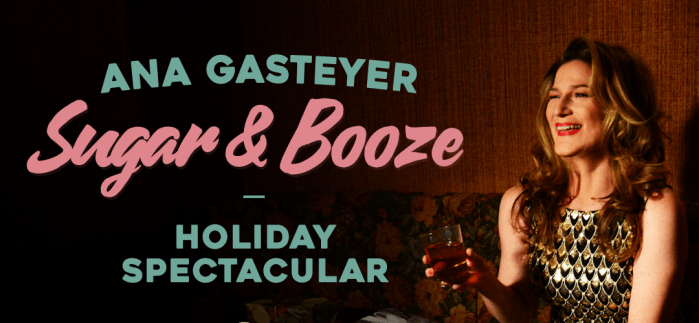Two lesbian couples send up an already very camp literary genre
Browsing for a gift for that friend with the literary bent? Perhaps you’ve considered queer pulp fiction. Instead, you might think about scoring a fistful of tickets to Lesbian Pulp-O-Rama’s holiday show, “A Very Pulpy Christmas” at HERE.
What exactly is pulp?
“It was a genre of dime-store paperbacks, created over half a century ago, and called ‘pulp’ novels because of the cheap quality of paper they were printed on,” explained company member Gretchen M. Mich-elfeld. “They ran wild with gin-swilling detectives, drug-crazed beatniks, gun molls, and rebellious debutantes who lived out lurid fantasies and died violent deaths. The wicked stepsister of pulp fiction was lesbian pulp––tawdry tales of forbidden love between strippers, nurses, WACS, cowgirls, convicts, and sorority sisters. The formula was pretty consistent—a warped, dark-haired butch seduces innocent, fair femme, and the story always ended tragically.”
Lesbian Pulp-O-Rama was formed as a troupe in June 2001, composed of four women who form two couples—Michelfeld and Beatrice Terry, and Heather de Michele and Anna Fitzwater. Terry has written and directed projects for EST, New Georges, and Vermont Stage Company. De Michele’s credits include “Misogamy” at Interart, and she currently directs the “American Dolls Review” now running Rockefeller Center. Fitzwater, who performs in the “Review,” also appeared in “Misogamy” and in New Georges’ “Fool for Love.” Michelfeld has acted in numerous local productions, and recently taught Shakespeare at Texas A&M University.
“This pulp thing all started when Gretchen and I got a lesbian pulp fiction address book for Christmas,” Terry recalled. “We looked through it, laughing over our burritos, and came up with the idea of doing a show. We decided we were going to create all of it, and be in it too.”
The four got together and soon wrote up a proposal for the 2001 Queer@HERE Festival—five pages of what became “Women Behind Bars.” Their first show became an immediate Festival hit. They’ve since performed at McCarter Theatre’s after-hours party in New Jersey, the Gay and Lesbian Expo, and the “Broads” performance lab sponsored by PSNBC, as well as at various benefits.
“We take our titles from real pulp books and go from there,” said Terry. “We read lots of pulp, and love the overdramatic, breathless quality—plus the innocent heart, though it can get pretty steamy. Heather and Anna do the coming-of-age stories, Gretchen does film-noir related material, and I do musical comedy, but they all have the same structure. There are always three or four pieces in a show, and in between there’s a running ballad sung by the Dyke Balladeer—Melineh Kurdian—who also writes the music. She’s been with us since the beginning, as has Emily Burton, who acts and does our choreography.”
According to Terry, all ideas and scripts are done collectively, and the group, which is “really tight,” has been putting up shows twice a year. Last season, there was even a special “eye-opening” tour to Sweden.
“They have equal rights for gays there,” Terry reported, “but the kicker is the general population doesn’t really know what gay people are about. So we had packed houses and so much press.”
They’ve also met Ann Bannon, the so-called queen of lesbian pulp, author of at least four novels in the 1960s, and best known for her classic scorcher, “Beebo Brinker.”
“We appeared at her benefit in the fall of 2002,” says Terry. “She was very complimentary and she said we were hot!”
For their current show, “A Very Pulpy Christmas,” the Lesbian Pulp-O-Rama girls have their first real set, in addition to signature over-the-top costumes and wigs, special sound design, and three “longish” sketches filled with “campy melodrama mated with lust.”
“Sorority Sluts” deals with two sorority girls who have to stay at school over the break. What’s a girl to do? Then there’s “Hollywood Harlots,” about a studio, run by Lotta Fistin, and the young reporter who falls in love with an ingénue. The last sketch, “Orphans! The Musical,” involves an orphanage run by a cruel dominatrix, complete with leather corset and iron whip, who can’t stop the magic of Christmas. The ballad in this show is called “Ballad of Ebeneeza Scrooge,” in which a young woman, called a lesbian in her hometown, runs away to live a straight life until she’s visited by ghosts of lesbian loves past, present, and future.
“We certainly want people to see these stories and have a fantastic time,” Terry said, “and we’re actually getting a cross-over audience, as people bring their friends. Also, the topic here is often first love. Everyone can relate to that and to having a relationship they can’t tell anyone about. Plus, it’s high style campy, so they all laugh a lot.”
Does Lesbian Pulp-O-Rama have a definite mission in mind?
“We’re dedicated to the subject because of the lesbian content,” Terry said. “But pulp fiction usually ends tragically, due to a sinful lifestyle. We send that up by having ridiculous tragic endings, and then pervert the genre by including a sort of happy ending afterward. As we say in our program, for us, pulp is not only a genre, but an ephemeral yet unmistakable quality. It’s an awkward glance, a blatant stare, a wicked laugh, a passionate sob, a forbidden dance and a tacky costume. Pulp’s triumph for us is in the moment when the heroine stands tall and proud and declares her love for another woman. And if she’s wearing a fabulous wig and a push-up bra… all the better!”
PHOTO BY Heather DeMichelle





































